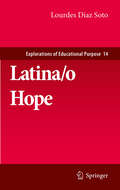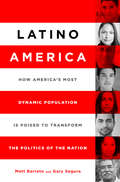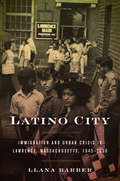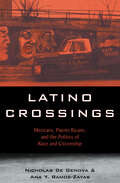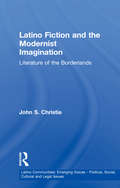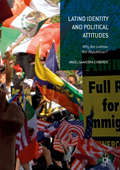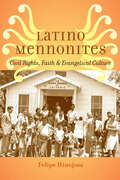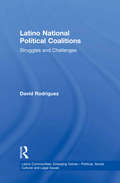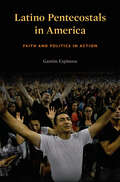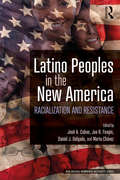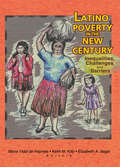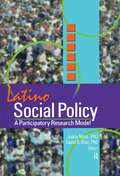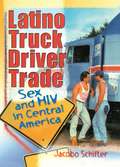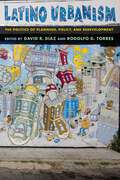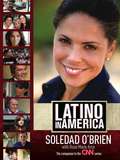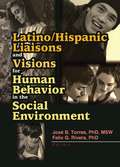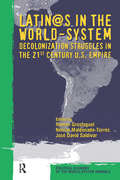- Table View
- List View
Latina/o Hope
by Lourdes Diaz SotoThere are an estimated forty-eight million Latinas/os living in the United States, roughly sixteen percent of the population. Not only are they the largest minority group in the country but also the youngest: one out of five children is Latina/o. The rise in the Latina/o population has caused for panic in some areas of the country, resulting in hostile and sometimes violent racism and xenophobia, and yet, much of that hatred is fueled not on facts but rather on myths about immigration. To date, most studies on immigration have been data driven, focusing on migrating groups or policy analyses. Latina/o Hope is different. It incorporates salient theories on migration as it moves toward a new theorizing, one that views immigration from the immigrant's perspective. Thus, it integrates research into the depiction of various slices of immigrant experience--the young women disappearing in the city of Juarez, the various students at various stages of their educational journeys, the young children in need of ESL programs, the ethnically-mixed immigrants, the undocumented workers, and others. Latina/o Hope discusses the impact of neoliberal policies and global capitalization on the daily lives of Latina/o immigrants, serving as an inspiration for dialogue, praxis and imagination to love and serve one another.
Latine Psychology Beyond Colonialism (International and Cultural Psychology)
by Edil Torres RiveraThis book examines the colonial structure as it applies to Latine populations and demonstrates how the remnants of that structure continue to affect this ethnic group. It will show that the colonial perspective is aligned with a racist viewpoint and the many ways in which this undermines psychological stability. Currently, many psychologists dealing with this population focus on individual deficits or disorders without the clarifying lens of social justice. In this way, the book will unravel the various strands of socio-political stressors and the disabling effects of lingering oppression. It will serve to bring new insights to those studying this group, as well as the many mental health workers that provide services. The result is an identification of a native psychology that is uniquely tailored to these particular individuals.
Latino America: How America's Most Dynamic Population is Poised to Transform the Politics of the Nation
by Gary M. Segura Matt BarretoSometime in April 2014, somewhere in a hospital in California, a Latino child tipped the demographic scales as Latinos displaced non-Hispanic whites as the largest racial/ethnic group in the state. So, one-hundred-sixty-six years after the Treaty of Guadalupe Hidalgo brought the Mexican province of Alta California into the United States, Latinos once again became the largest population in the state. Surprised? Texas will make the same transition sometime before 2020. When that happens, America’s two most populous states, carrying the largest number of Electoral College votes, will be Latino. New Mexico is already there. New York, Florida, Arizona, and Nevada are shifting rapidly. Latino populations since 2000 have doubled in Alabama, Arkansas, Georgia, and South Dakota. The US is undergoing a substantial and irreversible shift in its identity. So, too, are the Latinos who make up these populations. Matt Barreto and Gary M. Segura are the country’s preeminent experts in the shape, disposition, and mood of Latino America. They show the extent to which Latinos have already transformed the US politically and socially, and how Latino Americans are the most buoyant and dynamic ethnic and racial group, often in quite counterintuitive ways. Latinos’ optimism, strength of family, belief in the constructive role of government, and resilience have the imminent potential to reshape the political and partisan landscape for a generation and drive the outcome of elections as soon as 2016.
Latino American Civil Rights (Hispanic Americans: Major Minority)
by Thomas ArkhamAmericans with darker skin colors have often faced discrimination in the United States. Hispanic Americans, like other minority groups, have had to fight to be treated fairly. Today, there are millions of Hispanics in the country, spread across every state of the nation. They are the fastest growing minority in the United States--but the fact that they are spread out makes them weaker as a group. Hispanics must work together to stand up for their rights. Learn about the Latino civil rights movement. Find out how Hispanic Americans are fighting for their rights!
Latino City: Immigration and Urban Crisis in Lawrence, Massachusetts, 1945–2000 (Justice, Power, and Politics)
by Llana BarberLatino City explores the transformation of Lawrence, Massachusetts, into New England's first Latino-majority city. Like many industrial cities, Lawrence entered a downward economic spiral in the decades after World War II due to deindustrialization and suburbanization. The arrival of tens of thousands of Puerto Ricans and Dominicans in the late twentieth century brought new life to the struggling city, but settling in Lawrence was fraught with challenges. Facing hostility from their neighbors, exclusion from local governance, inadequate city services, and limited job prospects, Latinos fought and organized for the right to make a home in the city. In this book, Llana Barber interweaves the histories of urban crisis in U.S. cities and imperial migration from Latin America. Pushed to migrate by political and economic circumstances shaped by the long history of U.S. intervention in Latin America, poor and working-class Latinos then had to reckon with the segregation, joblessness, disinvestment, and profound stigma that plagued U.S. cities during the crisis era, particularly in the Rust Belt. For many Puerto Ricans and Dominicans, there was no "American Dream" awaiting them in Lawrence; instead, Latinos struggled to build lives for themselves in the ruins of industrial America.
Latino Crossings: Mexicans, Puerto Ricans, and the Politics of Race and Citizenship
by Ana Yolanda Ramos-Zayas Nicholas De GenovaFirst published in 2003. Routledge is an imprint of Taylor & Francis, an informa company.
Latino Farmworkers in the Eastern United States
by Sara A. Quandt Thomas A. ArcuryThey work at some of America's most hazardous jobs, have few protections, and receive some of the lowest wages. Latino Farmworkers in the Eastern United States describes this understudied and underserved population. Taking a social justice stance, this volume examines the health and living conditions of workers in agriculture, while advocating for equality. Contributors cover all major areas of illness and injury (including occupational, environmental, infections, and pesticides), while also focusing on systemic social conditions, from lax industry regulations to lack of basic services--problems that are exacerbated by workers' status as recent immigrants. Mental health burdens from the effects of discrimination to substance use, as well as the cumulative impact of workers' separation from families are discussed for a comprehensive, meticulously documented resource. Written to serve both the seasoned professional and the newcomer, Latino Farmworkers in the Eastern United States is a bedrock source of information for those providing health and social services in the community, for researchers investigating health and safety disparities, and for advocates and policymakers working to correct them.
Latino Fiction and the Modernist Imagination: Literature of the Borderlands (Latino Communities: Emerging Voices - Political, Social, Cultural and Legal Issues)
by John S. ChristieFirst published in 1999. Routledge is an imprint of Taylor & Francis, an informa company. The aim of this book is to approach Latino fiction from a wider perspective, and to cross the standard critical boundaries between Latino groups in order to focus upon the literary language of a collection of complicated novels and stories.
Latino Gay Men and HIV: Culture, Sexuality, and Risk Behavior
by Rafael M. DiazWith research based on focus group and individual interviews in the United States, as well as a thorough and integrative review of the current literature, Latino Gay Men and HIV discusses the six main sociocultural factors in Latino communities -- machismo, homophobia, family cohesion, sexual silence, poverty and racism--which undermine safe sex practices. In an attempt to explain the alarmingly high incidence of unprotected intercourse in this population, this in-depth cultural and psychological analysis shows how an apparent incongruence between knowledge or intention and behavior can possess its own sociocultural logic and meaning.
Latino Heartland: Of Borders and Belonging in the Midwest
by Sujey VegaAddresses the politics of immigration, in the everyday lives of one communityNational immigration debates have thrust both opponents of immigration and immigrant rights supporters into the news. But what happens once the rallies end and the banners come down? What is daily life like for Latinos who have been presented nationally as “terrorists, drug smugglers, alien gangs, and violent criminals”? Latino Heartland offers an ethnography of the Latino and non-Latino residents of a small Indiana town, showing how national debate pitted neighbor against neighbor—and the strategies some used to combat such animosity. It conveys the lived impact of divisive political rhetoric on immigration and how race, gender, class, and ethnicity inform community belonging in the twenty-first century. Latino Heartland illuminates how community membership was determined yet simultaneously re-made by those struggling to widen the scope of who was imagined as a legitimate resident citizen of this Midwestern space. The volume draws on interviews with Latinos—both new immigrants and long-standing U.S. citizens—and whites, as well as African Americans, to provide a sense of the racial dynamics in play as immigrants asserted their right to belong to the community. Latino Hoosiers asserted a right to redefine what belonging meant within their homes, at their spaces of worship, and in the public eye. Through daily acts of ethnic belonging, Spanish-speaking residents navigated their own sense of community that did not require that they abandon their difference just to be accepted. In Latino Heartland, Sujey Vega addresses the politics of immigration, showing us how increasingly diverse towns can work toward embracing their complexity.
Latino Identity and Political Attitudes: Why Are Latinos Not Republican?
by Angel Saavedra CisnerosThis book explores the forces that shape Latino political preferences, arguing that social identities are at the center of Latino partisanship. Despite hopes of the Republican Party for bringing in Latinos through religious and moral issues, Latinos in America consistently side with the Democratic Party. Two possible explanations based on social identity emerge as theories of Latino partisanship. The first possibility is that Latinos behave as a single-issue public driven politically by the issue of immigration. A thorough exploration of this possibility in part two of the book finds very little evidence to justify treating Latinos as a single-issue public. The second explanation, presented in part three, relies more heavily on the concept of social identities. Latino pan-ethnic identity emerges as one of multiple identities available to Latinos in America. These multiple, diverse, and overlapping identities are the force behind Latino partisanship. Latino ethnic identity trumps the impact of religious identities in making Latinos more Democratic.
Latino Mennonites: Civil Rights, Faith, and Evangelical Culture (Young Center Books in Anabaptist and Pietist Studies)
by Felipe HinojosaThe first historical analysis of the changing relationship between religion and ethnicity among Latino Mennonites.Winner, 2015 Américo Paredes Book Award, Center for Mexican American Studies and South Texas College.Felipe Hinojosa's parents first encountered Mennonite families as migrant workers in the tomato fields of northwestern Ohio. What started as mutual admiration quickly evolved into a relationship that strengthened over the years and eventually led to his parents founding a Mennonite Church in South Texas. Throughout his upbringing as a Mexican American evangélico, Hinojosa was faced with questions not only about his own religion but also about broader issues of Latino evangelicalism, identity, and civil rights politics.Latino Mennonites offers the first historical analysis of the changing relationship between religion and ethnicity among Latino Mennonites. Drawing heavily on primary sources in Spanish, such as newspapers and oral history interviews, Hinojosa traces the rise of the Latino presence within the Mennonite Church from the origins of Mennonite missions in Latino communities in Chicago, South Texas, Puerto Rico, and New York City, to the conflicted relationship between the Mennonite Church and the California farmworker movements, and finally to the rise of Latino evangelical politics. He also analyzes how the politics of the Chicano, Puerto Rican, and black freedom struggles of the 1960s and 1970s civil rights movements captured the imagination of Mennonite leaders who belonged to a church known more for rural and peaceful agrarian life than for social protest.Whether in terms of religious faith and identity, race, immigrant rights, or sexuality, the politics of belonging has historically presented both challenges and possibilities for Latino evangelicals in the religious landscapes of twentieth-century America. In Latino Mennonites, Hinojosa has interwoven church history with social history to explore dimensions of identity in Latino Mennonite communities and to create a new way of thinking about the history of American evangelicalism.
Latino National Political Coalitions: Struggles and Challenges (Latino Communities: Emerging Voices - Political, Social, Cultural and Legal Issues)
by David RodriguezThis study examines Latino national political coalitions in the United States with a focus on Chicanos, Puerto Ricans, and Cubans. It argues that Latino national political coalitions are an avenue of political empowerment for the Latino Community, but face social, economic, and political challenges in the Latino community.
Latino Pentecostals in America: Faith and Politics in Action
by Gastón EspinosaThis &“excellent study&” of the Latino Pentecostal movement is &“an important resource for understanding the future of Christianity in North America&” (Choice). Every year an estimated 600,000 U.S. Latinos convert from Catholicism to Protestantism, a transformation spearheaded by the Pentecostal movement and Assemblies of God. Latino Assemblies of God leaders—and their 2,400 churches across the nation—represent a new and growing force in denominational, Evangelical, and presidential politics. In a deeply researched social and cultural history, Gastón Espinosa uncovers the roots and contemporary developments of this remarkable turn.Latino Pentecostals in America traces the Latino AG back more than a century, to the Azusa Street Revivals in Los Angeles and Apostolic Faith Revivals in Houston from 1906 to 1909. Espinosa describes the uphill struggles for indigenous leadership, racial equality, women in the ministry, social and political activism, and immigration reform. Their outspoken commitment to an active faith has led a new generation of leaders to combine the reconciling message of Billy Graham with the social transformation politics of Martin Luther King Jr. This eye-opening study explains why this group of working-class Latinos once called "the Silent Pentecostals" is silent no more. By giving voice to their untold story, Espinosa enriches our understanding of the diversity of Latino religion, Evangelicalism, and American culture.
Latino Peoples in the New America: Racialization and Resistance
by Joe R. Feagin José A. Cobas Daniel J. Delgado Maria Chávez"Latinos" are the largest group among Americans of color. At 59 million, they constitute nearly a fifth of the US population. Their number has alarmed many in government, other mainstream institutions, and the nativist right who fear the white-majority US they have known is disappearing. During the 2016 US election and after, Donald Trump has played on these fears, embracing xenophobic messages vilifying many Latin American immigrants as rapists, drug smugglers, or "gang bangers." Many share such nativist desires to build enhanced border walls and create immigration restrictions to keep Latinos of various backgrounds out. Many whites’ racist framing has also cast native-born Latinos, their language, and culture in an unfavorable light. Trump and his followers’ attacks provide a peek at the complex phenomenon of the racialization of US Latinos. This volume explores an array of racialization’s manifestations, including white mob violence, profiling by law enforcement, political disenfranchisement, whitewashed reinterpretations of Latino history and culture, and depictions of "good Latinos" as racially subservient. But subservience has never marked the Latino community, and this book includes pointed discussions of Latino resistance to racism. Additionally, the book’s scope goes beyond the United States, revealing how Latinos are racialized in yet other societies.
Latino Poverty in the New Century: Inequalities, Challenges, and Barriers
by Elizabeth Segal Keith Kilty Maria Vidal De HaymesUnderstand the social factors that challenge this fast-growing community!The Latino community will soon be the largest minority population in the United States. Although Hispanics have been part of the American scene since before independence, their issues have only recently drawn the attention of the mainstream. Latino Poverty in the New Century takes a clear look at the reasons why poverty and inequality are still major concerns for Hispanic citizens and residents. This keen analysis examines how apparently neutral, even well-meaning social and educational policies can have a devastating effect. The interlocking consequences of language problems, educational problems, gangs, poverty, and illness become a vicious cycle. Despite pervasive patterns of discrimination and subtle barriers to achievement, the Latino community still displays its power. Latino Poverty in the New Century reveals how a faith-based community organization succeeded in adapting indigenous networks and culturally relevant sources of support and power to create a strong community presence.Latino Poverty in the New Century offers a rich, detailed analysis of the challenges that face Hispanics in the United States: the implications of US immigration policy for immigrants, refugees, and native-born Latino citizens the language barriers that can prevent Latinos from full participation in both society and educational programs health care policies and the sometimes tragic consequences of the lack of medical insurance the role of extracurricular activities in keeping Latino students in school the twin calamities known as gentrification and urban blightThis comprehensive book provides social workers and policymakers with wide-ranging analyses of some of the pressing issues and social policies that affect Hispanics in the United States. Latino Poverty in the New Century explores ways to keep Latino youth in high school, promote community organization, encourage Latinos to vote, and increase your understanding of migration dynamics. Containing current research and case studies, this valuable book will help you comprehend the challenges that Latinos face in this country and respect the gains they have made in spite of the obstacles in their way.
Latino Professionals in America: Testimonios of Policy, Perseverance, and Success
by Maria ChávezIn Latino Professionals in America, Maria Chávez combines rich qualitative interviews, auto-ethnographic accounts, and policy analysis to explore the converging oppressions that make it difficult for Latinos to become professionals and to envision themselves as successful in those professions. Recounting her own story, Chávez interviews 31 Latino professionals from across the nation in a variety of occupations and careers, contextualizing their experiences amid family struggles and ongoing racism in the United States. She addresses gender inequality within the Latino community, arguing that by defending, rationalizing, or ignoring patriarchy within the Latino community perpetuates systems of oppression—especially for women; gay, lesbian, bisexual, transgender, and queer individuals; and others at the intersections. The experiences of these Latino professionals and the author’s analysis provide a blueprint for what works—one, both pragmatic and hopeful, that uses real lives to illustrate how a combination of public policies, people, and perseverance increases the presence of America’s fastest-growing demographic group in the professional class.
Latino Social Policy: A Participatory Research Model
by David Diaz Juana MoraExamine alternative strategies to resolving important Latino social issues! Latino Social Policy: A Participatory Research Model examines the failure of traditional research methods to address major social needs in Latino communities, promoting instead a participatory/action approach to research that is socially-and scientifically-meaningful. Experts from a variety of disciplines focus on nontraditional strategies that engage community residents in community-research projects, shortening the distance between the researcher and the "subject." This unique book recounts lessons learned on conducting Participatory Action Research (PAR) in Latino communities using techniques based on anthropology, education, community health and evaluation, and urban planning. Latino Social Policy: A Participatory Research Model addresses non-traditional methods of reducing the tension between the reality of interaction with the subject community and the academic training structures used by researchers. The book promotes a new vision and practice of research design in which the "subject" is central to the process, advocating a participatory approach to produce qualitatively different research based on community identified problems and needs. Contributors examine the value of integrating local knowledge, language, and culture into the methodological design, the ethics of conducting research in Latino communities, and the internal conflicts Chicana/o researchers face within their profession and in the field. Topics addressed in Latino Social Policy: A Participatory Research Model include: community health and Central Americans in Los Angeles ethnography and substance abuse among transnational Mexican farmworkers identity and field research in Mexico the Latino Coalition for a New Los Angeles (LCNLA) researcher/community partnerships and much more! Latino Social Policy: A Participatory Research Model includes case studies, ethnographies, and vignettes that illustrate participatory approaches and outcomes in Latino research. The book is equally valuable as a textbook for academics and students working in the social sciences, public policy, and urban planning, and as a professional guide for community leaders and organizations interested in developing research partnerships.
Latino Truck Driver Trade: Sex and HIV in Central America
by Johnny MadrigalWhat do truckers do about their sexual needs on the road?This startling and unique study examines the on-the-road sex lives of Central American truck drivers. It takes a quantitative and qualitative look at the extent of homosexuality, prostitution, drug use, and vulnerability to HIV infection among these men who operate in a strangely unique sexual culture. Latino Truck Driver Trade: Sex and HIV in Central America documents the extent of their sexual activities with both men and women as well as drug use and prostitution among this population. Honest and revealing, this valuable book uncovers the incredible danger that truck drivers put themselves in by risking HIV infection and why Latin sexual culture does not always define men who participate in acts with other men as “homosexual.” Latino Truck Driver Trade explores the concept of “machismo” and why truck drivers act very “manly” (to avoid being teased or being made fun of).Through interviews with truck drivers, this detailed account gives insight into how friends pressure others to perform sexual acts, drink alcohol, and take drugs in order to “fit in.” Latino Truck Driver Trade: Sex and HIV in Central America provides suggestions for HIV prevention programs to decrease the spread of HIV that is prevalent among this group shows how theories of homosexuality fail to account for its widespread practice among Latino heterosexual men explores the sexual practices of these men questions basic assumptions about Latin machismo demonstrates how Latino men can practice homosexuality without acquiring a gay identity shows how this international truck driver culture will impact the U. S.Latino Truck Driver Trade explicitly examines the on-the-road lifestyles of Central American truckers, revealing that many times they are completely the opposite of the quiet, “normal” lives these men lead at home.
Latino Urban Ethnography and the Work of Elena Padilla
by Merida M. RuaThis study reclaims and builds upon the classic work of anthropologist Elena Padilla in an effort to examine constructions of space and identity among Latinos. The volume includes an annotated edition of Padilla's 1947 University of Chicago master's thesis, "Puerto Rican Immigrants in New York and Chicago: A Study in Comparative Assimilation," which broke with traditional urban ethnographies and examined racial identities and interethnic relations. Weighing the importance of gender and the interplay of labor, residence, and social networks, Padilla examined the integration of Puerto Rican migrants into the social and cultural life of the larger community where they settled. Also included are four comparative and interdisciplinary original essays that foreground the significance of Padilla's early study about Latinos in Chicago. Contributors discuss the implications of her groundbreaking contributions to urban ethnographic traditions and to the development of Puerto Rican studies and Latina/o studies. Contributors are Nicholas De Genova, Zaire Z. Dinzey-Flores, Elena Padilla, Ana Y. Ramos-Zayas, Mérida M. Rúa, and Arlene Torres.
Latino Urbanism: The Politics of Planning, Policy and Redevelopment
by Rodolfo D. Torres David R. DiazThe nation’s Latina/o population has now reached over 50 million, or 15% of the estimated total U.S. population of 300 million, and a growing portion of the world’s population now lives and works in cities that are increasingly diverse. Latino Urbanism provides the first national perspective on Latina/o urban policy, addressing a wide range of planning policy issues that impact both Latinas/os in the US, as well as the nation as a whole, tracing how cities develop, function, and are affected by socio-economic change.The contributors are a diverse group of Latina/o scholars attempting to link their own unique theoretical interpretations and approaches to political and policy interventions in the spaces and cultures of everyday life. The three sections of the book address the politics of planning and its historic relationship with Latinas/os, the relationship between the Latina/o community and conventional urban planning issue sand challenges, and the future of urban policy and Latina/o barrios. Moving beyond a traditional analysis of Latinas/os in the Southwest, the volume expands the understanding of the important relationships between urbanization and Latinas/os including Mexican Americans of several generations within the context of the restructuring of cities, in view of the cultural and political transformation currently encompassing the nation.
Latino in America
by Soledad O'BrienNewsanchor Soledad O'Brien takes an in-depth look at today's Latino experience-- as her own-- with interviews, pictures, and travelogues about the country's largest minority...
Latino-Anglo Bargaining: Culture, Structure and Choice in Court Mediation (Latino Communities: Emerging Voices - Political, Social, Cultural and Legal Issues)
by Christine RackThis book shows the mechanisms by which cultural differences reinforce structural privilege and disadvantage in the informal process of mediated negotiation. Are all people equally likely to pursue their own material self-interest in the negotiation process used in small claims mediation? Did Latinos and Anglos bargain more generously with members of their own group? The central questions, derived from theories of ethnic and gender differences, concerned how, and to what degree; culture, structure, and individual choice operated to alter the goals, bargaining process and outcomes, expressed motivations and outcome evaluations for outsider groups. This book demonstrates how there are real cultural differences in the way that Latinos and Anglos pursue monetary justice that defy dominant assumptions that all culture groups are equally likely to maximize their own outcomes at the expense of others.
Latino/Hispanic Liaisons and Visions for Human Behavior in the Social Environment
by Felix G RiveraAdd to your knowledge of Latino/Hispanic diversity, attitudes, behaviors, and experiences to provide more effective services!Latino-Hispanic Liaisons and Visions for Human Behavior in the Social Environment dispels pervasive historical and contemporary misconceptions and inaccuracies and highlights the diversity of Latino/Hispanic experiences to help you provide more effective services to those clients. As editors Torres and Rivera point out, “Literature on Latinos/Hispanics reflects a dysfunctional and myopic cultural view in which they are often depicted in stereotypic characteristics and as a homogenous population.”In Latino-Hispanic Liaisons and Visions for Human Behavior in the Social Environment, you&’ll find chapters examining: the social ecology of Mexican-American child development caregiver well-being among Cuban and Puerto Rican mothers of mentally retarded adults the adjustment process among Cuban refugee families one Southwestern community’s efforts to create a multiethnic neighborhood coalition against substance abuse a study of changes related to migration, family, and work in Caribbean women’s lives and much more!
Latino/as in the World-system: Decolonization Struggles in the 21st Century U.S. Empire (Political Economy of the World-System Annuals)
by Nelson Maldonado-Torres Ramon Grosfoguel Jose David SaldivarContributors Immanuel Wallerstein, Enrique Dussel, Walter Mignolo, Agustin Lao, Lewis Gordon, James V. Fenelon, Roberto Hernandez, James Cohen, Santiago Slabosky, Susanne Jonas, and Thomas Reifer. By the mid-twenty-first century, white Euro-Americans will be a demographic minority in the United States and Latino/as will be the largest minority (25 percent). These changes bring about important challenges at the heart of the contemporary debates about political transformations in the United States and around the world. Latino/as are multiracial (Afro-latinos, Indo-latinos, Asian-latinos, and Euro-latinos), multi-ethnic, multireligious (Jewish, Catholic, Protestant, Muslim, indigenous, and African spiritualities), and of varied legal status (immigrants, citizens, and illegal migrants). This collection addresses for the first time the potential of these diverse Latino/a spiritualities, origins, and statuses against the landscape of decolonization of the U.S. economic and cultural empire in the twenty-first century. Some authors explore the impact of Indo-latinos and Afro-latinos in the United States and others discuss the conflicting interpretations and political conflicts arising from the "Latinization" of the United States.
